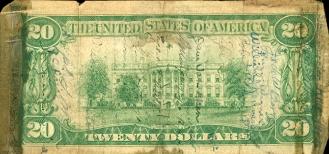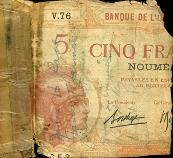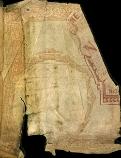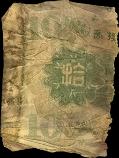
| Charles W. King Short Snorter |
The Short Snorter Project
Charles W. King was an Army Air Corps fighter ace with the 39th Fighter Squadron in New Guinea during World War 2.
His son, Gary, found his father's short snorter and notebook with listings of all the signers and contacted Doug Mudd,
Curator at the American Numismatic Association, who facilitated contact and scanning of these images for The Short
Snorter Project web site. Signers include Tommy Lynch, Buzz Wagner, Hoyt Eason, "Sully" Sullivan, and many other top
aces of the South Pacific. The 39th Fighter Squadron was the first to score 100 kills and had 21 aces as well as many of
the finest pilots in the Army Air Force. Dick Bong became an ace in the 39th flying C. W. Kings P-38 "#27" and was the
top ace in the Pacific. What is extremely unusual, from a short snorter perspective, is the U. S. Twenty Dollars bank note
upon which the short snorter was created. This is the only one I have ever seen or heard of which opens up speculation
as to why a $20 bill was used for a short snorter. That was a lot of money, almost one month's pay, back in those days!
His son, Gary, found his father's short snorter and notebook with listings of all the signers and contacted Doug Mudd,
Curator at the American Numismatic Association, who facilitated contact and scanning of these images for The Short
Snorter Project web site. Signers include Tommy Lynch, Buzz Wagner, Hoyt Eason, "Sully" Sullivan, and many other top
aces of the South Pacific. The 39th Fighter Squadron was the first to score 100 kills and had 21 aces as well as many of
the finest pilots in the Army Air Force. Dick Bong became an ace in the 39th flying C. W. Kings P-38 "#27" and was the
top ace in the Pacific. What is extremely unusual, from a short snorter perspective, is the U. S. Twenty Dollars bank note
upon which the short snorter was created. This is the only one I have ever seen or heard of which opens up speculation
as to why a $20 bill was used for a short snorter. That was a lot of money, almost one month's pay, back in those days!
| C. W. King Short Snorter Note #1: U.S. Twenty Dollars Federal Reserve Note - Series 1934A - Serial # L19540343A |
| Two photographs of Charles W. "Snarlin' Charlie" King. Note the Japanese flags painted on the fuselage forward of the cockpit of his Lockheed P-38 Lightning. These denote his "kills" at the time. |

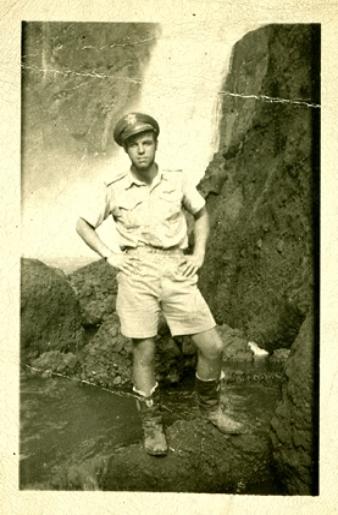
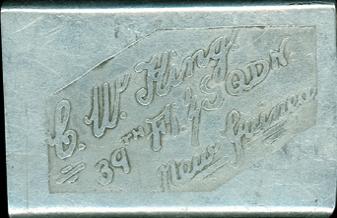
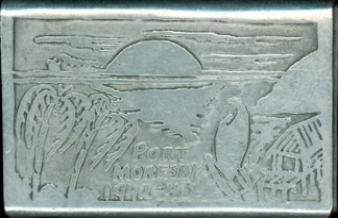
| Metal "trench art" inscribed "C. W. King, 39th Fi. / SQDN, New Guinea" and "PORT MORESBY, 1942-43". |
Some of things that stood out from Charles King's logbook...
- He flew MANY different airplanes, and many of the different models of the airplanes.
- He had substantial experience as a pilot - even before the war - about as much as any pilot might have.
- His tour of duty, especially in combat, was long. Probably about the longest of any 39th Fighter Squadron pilot.
- He was one of the original 39th Squadron pilots.
- He flew all over the U.S., especially the Eastern U.S.
- He was shipped out to Australia on the USS Ancon almost immediately following Pearl Harbor, so a first
responder into combat zone. - He flew all over Australia.
- He was in Australia at the time of the Battle of Coral Sea.
- He flew into the New Guinea combat zone during the Battle of Midway, before the major turning point of the war.
- He had heavy experience in the P-39 Air Cobra, especially in combat, and would be considered an expert in that
airplane. - He survived the lethal June-July 1942 air-combat action, when the 39th was so heavily outnumbered, especially
with inferior equipment. - He did a great job documenting his flights and the aircraft he flew, leaving an extremely well-detailed record
- He had only 6 hours time in the P-38 when he flew back into the PNG combat zone. Not very much time before
combat, greatly increasing risks to his life. - Even with such little time in the P-38, he volunteered to deputy command eight P-38s to Guadalcanal, which
contributed to his promotion to Captain. - He fell sick, was sent to Australia, missing big air battles of late Dec. 1942 / early January 1943, where the 39th
scored most heavily, but he still made ace. - He flew many of the 39th squadrons P-38's, but flew #27 (serial #42-12653) most frequently, and #20 (serial #42-
12621) next most frequently (Jack Jones' P-38). - He flew P-38F #42-12665 on Nov 8th - the P38 Uncle Johnny was lost in exactly 2 months later.
- He was a hero of the Battle of Bismarck Sea, one of greatest military victories in U.S. history, flying four missions
over the 3-day battle, and scored. - He had several "probables", in addition to his credited victories.
- As C.O. of the 39th, he took over plane #10, the command plane of the 39th FS, and a P-38H model, and flew it
extensively in combat. - He trained numerous squadron pilots.
- He flew all over New Guinea, and New Britain.
- He flew the P-47 Thunderbolt ("The Jug") in combat and stateside.
- He had over 1,000 flight hours during the war, most while in combat.
- He was a great ace pilot of the Army Air Corps, and leader of the 39th Fighter Squadron.


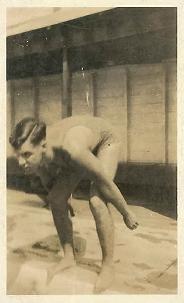
| Close-up photo of crown painted on left fuselage of Charles King's P-39. |
| Charles King ready to swim. |

